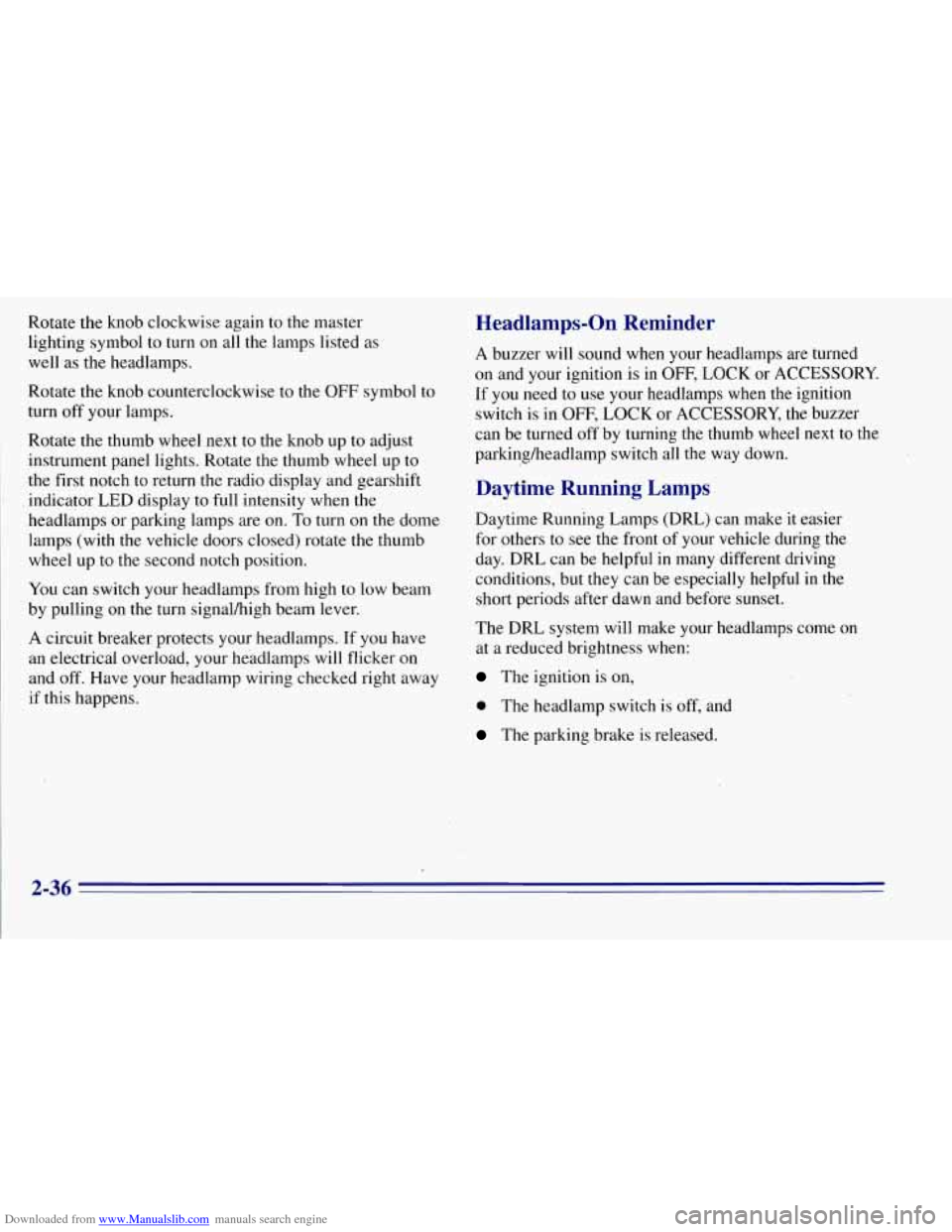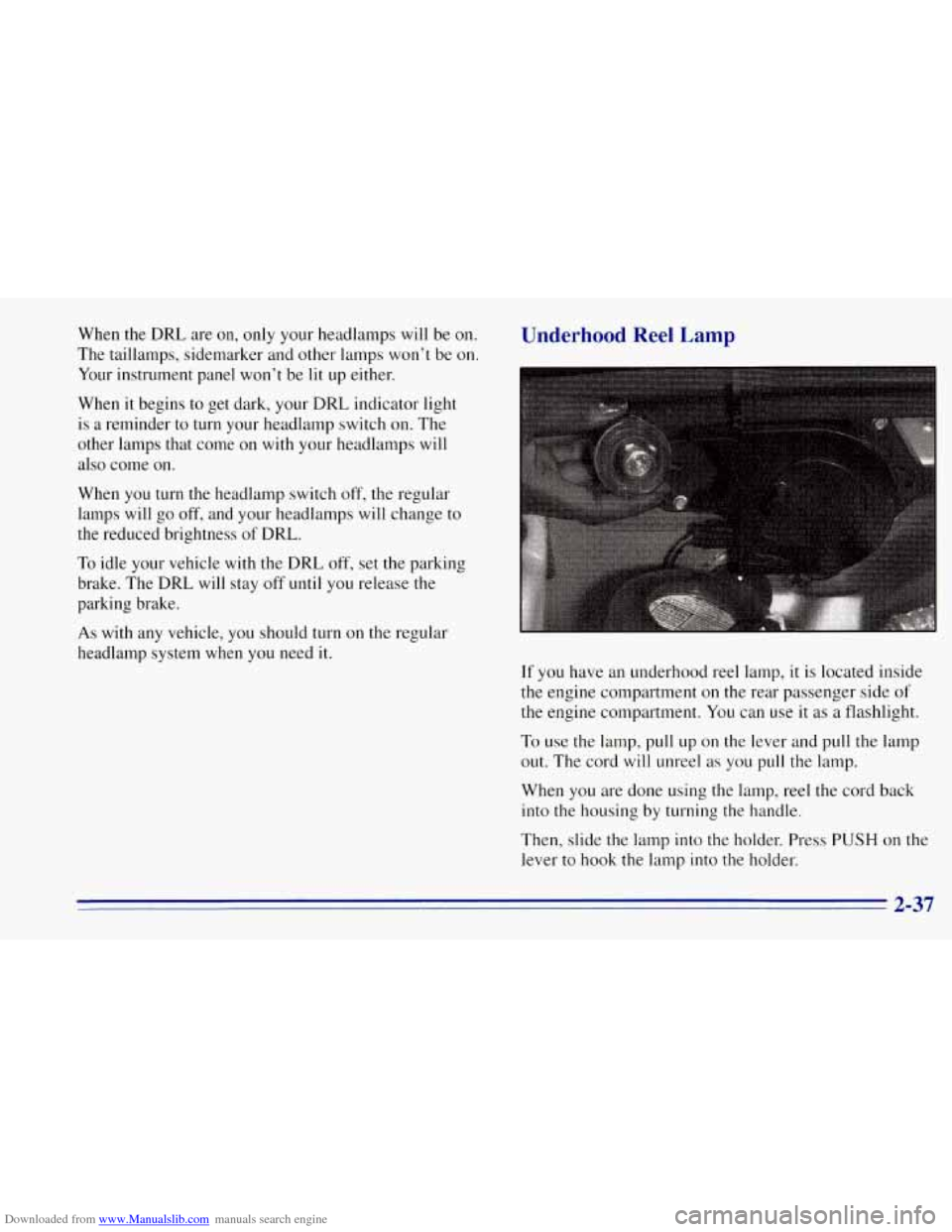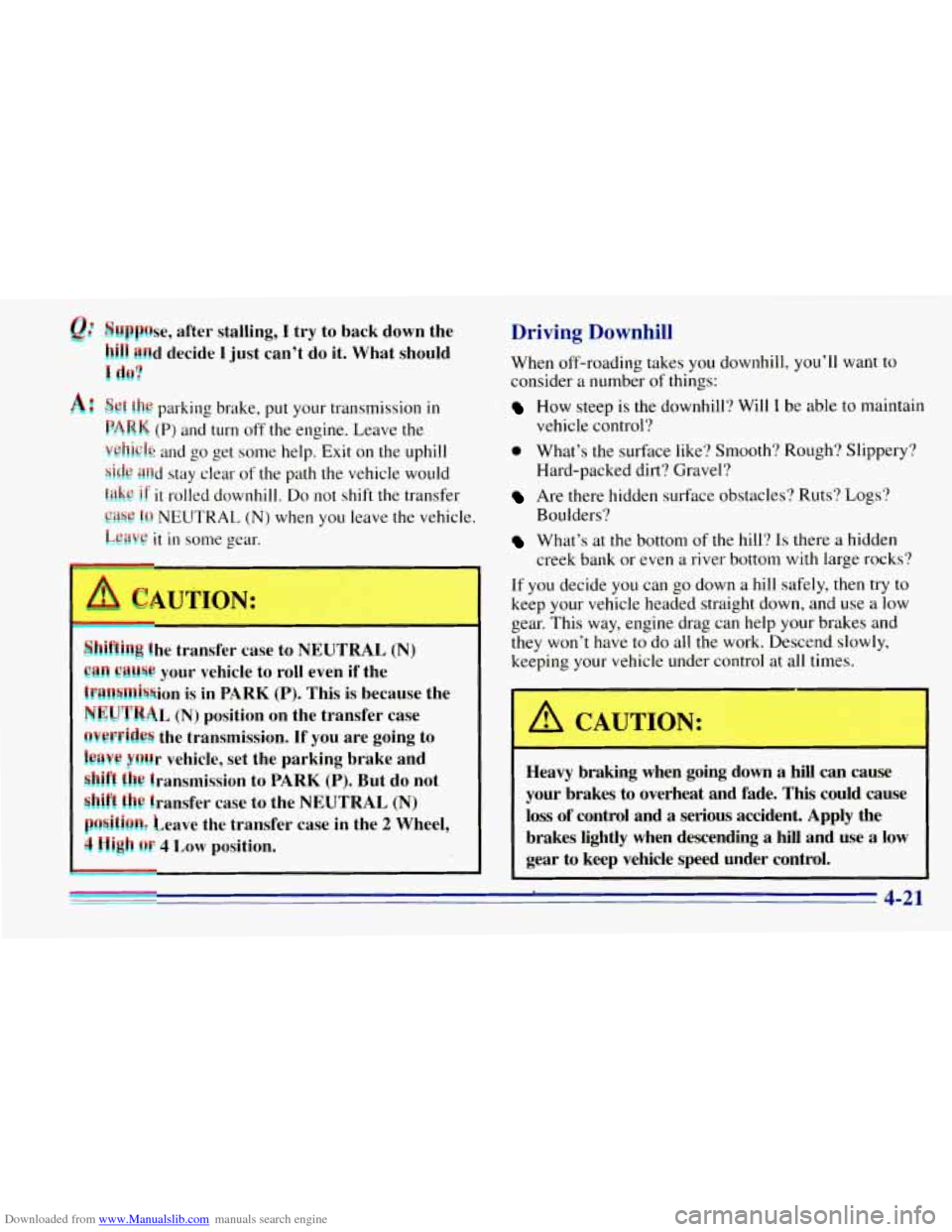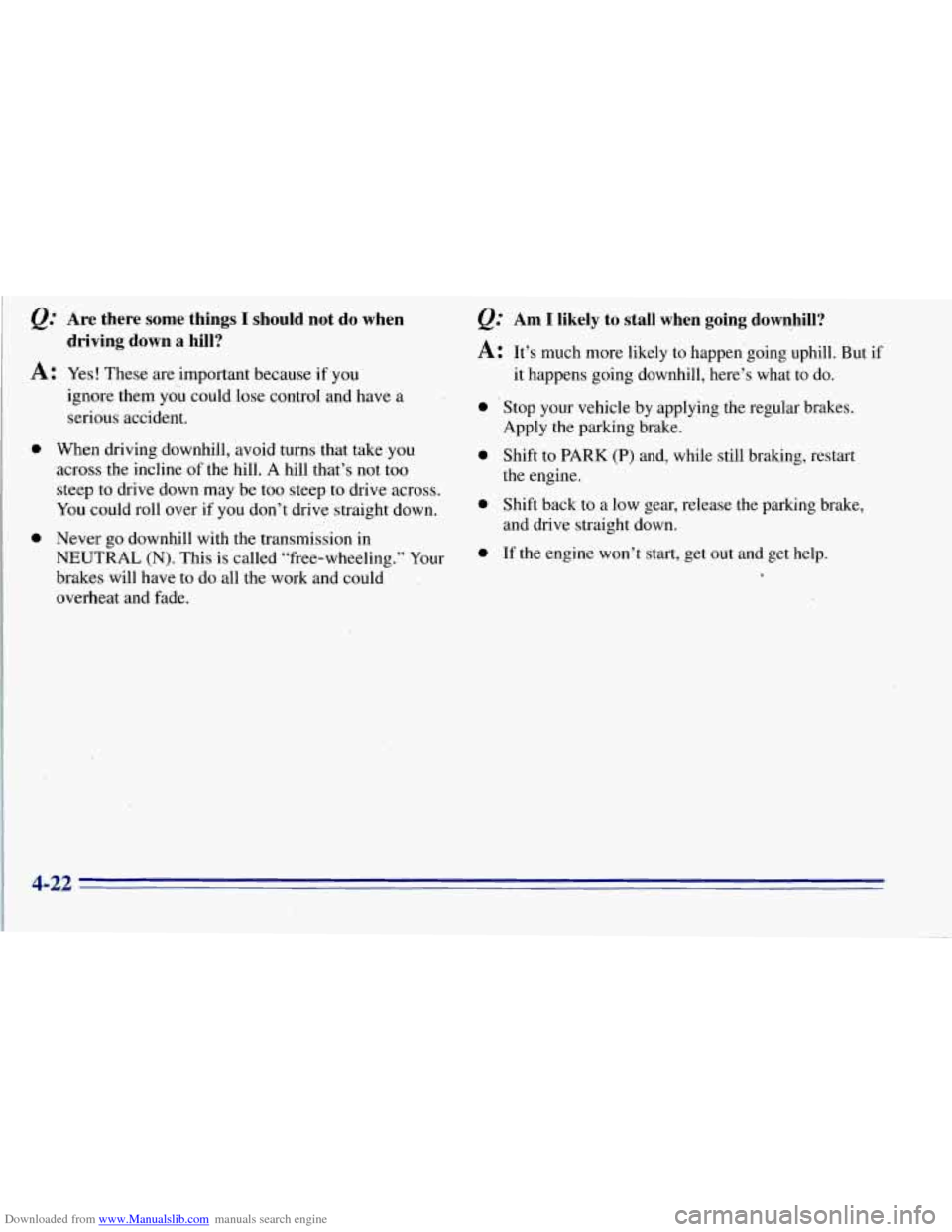1996 CHEVROLET TAHOE parking brake
[x] Cancel search: parking brakePage 99 of 403

Downloaded from www.Manualslib.com manuals search engine Rotate the knob clockwise again to the master
lighting symbol to turn on all
the lamps listed as
well as the headlamps.
Rotate the knob counterclockwise to the
OFF symbol to
turn
off your lamps.
Rotate the thumb wheel next to the knob up
to adjust
instrument panel lights. Rotate the thumb wheel up to
the first notch
to return the radio display and gearshift
indicator LED display to full intensity when the
headlamps or parking lamps are on.
To turn on the dome
lamps (with the vehicle doors closed) rotate the thumb
wheel up to the second notch position.
You can switch your headlamps from high
to low beam
by pulling on the turn signalhigh beam lever.
A circuit breaker protects your headlamps. If you have
an electrical overload, your headlamps will flicker on
and
off. Have your headlamp wiring checked right away
if this happens.
Headlamps-On Reminder
A buzzer will sound when your headlamps are turned
on and your ignition
is in OFF, LOCK or ACCESSORY.
If you need to use your headlamps when the ignition
switch is
in OFF, LOCK or ACCESSORY, the buzzer
can be turned off
by turning the thumb wheel next to the
parkingheadlamp switch all the way down.
Daytime Running Lamps
Daytime Running Lamps (DRL) can make it easier
for others to see the front of your vehicle during the
day. DRL can be helpful in many different driving
conditions, but they can be especially helpful
in the
short periods after dawn and before sunset.
The DRL system will make your headlamps come on
at a reduced brightness when:
The ignition is on,
0 The headlamp switch is off, and
The parking brake is released.
2-36
Page 100 of 403

Downloaded from www.Manualslib.com manuals search engine When the DRL are on, only your headlamps will be on.
The taillamps, sidemarker and other lamps won’t be on.
Your instrument panel won’t be
lit up either.
When
it begins to get dark, your DRL indicator light
is a reminder to
turn your headlamp switch on. The
other lamps that come on with your headlamps will
also come on.
When you
turn the headlamp switch off, the regular
lamps will go
off, and your headlamps will change to
the reduced brightness of DRL.
To idle your vehicle
with the DRL off, set the parking
brake. The DRL will stay
off until you release the
parking brake.
As with any vehicle, you should turn on the regular
headlamp system when
you need it.
Underhood Reel Lamp
If you have an underhood reel lamp, it is located inside
the engine compartment on the rear passenger side
of
the engine compartment. You can use it as a flashlight.
To use the lamp, pull up on the lever and pull the lamp
out. The cord
will unreel as you pull the lamp.
When
you are done using the lamp, reel the cord back
into the housing by turning the handle.
Then, slide the lamp into the holder. Press
PUSH on the
lever to hook the lamp into the holder.
2-37
Page 118 of 403

Downloaded from www.Manualslib.com manuals search engine A. Dome Lamp Switch
B. Lamp Controls
C. Air Vents
D. Multifunction Lever
E. Instrument Cluster
E Gearshift Lever
G. Audio ,System
H. Comfort Control System
I. Glove
Box
J. Storage Tray
K. Ashtray
L. Cupholder
M. Power Outlets
N. Storage Area or Optional. Compact Disc Player
0. Rear Window Defogger Switch
P. Tilt Lever
Q. Parking Brake Release Handle
R. Hood Release
S. Fuse Panel
2-55
Page 124 of 403

Downloaded from www.Manualslib.com manuals search engine Brake System Warning Light
Your vehicle’s hydraulic brake system is divided into
two parts. If one part isn’t working, the other part can
still work and stop you. For good braking, though, you
need both parts working well.
If the warning light comes on, there could be a brake
problem. Have your brake system inspected right away.
BRAKE
This light should come on
briefly when you turn the
ignition key to
RUN. If it
doesn’t come on then, have
it fixed
so it will be ready to
warn you if there’s a
problem.
If the light comes on while you are driving, pull off the
road and stop carefully. You may notice that the pedal
is
harder to push. Or, the pedal may go closer to the floor.
It may take longer to stop. If the light is still on, have the
vehicle towed for service. (See “Towing Your Vehicle”
in the Index.)
A CAUTION:
Your brake system may not be working properly
if the brake system warning light is on. Driving
with the brake system warning light
on can lead
to an accident. If the light is still on after you’ve
pulled off the road and stopped carefully, have
the vehicle towed for service.
When the ignition is on, the brake system warning light
will also come on when you set your parking brake. The
light will stay on if your parking brake doesn’t release
fully. If it stays on after your parking brake is fully
released, it means
you have a brake problem.
2-61
Page 179 of 403

Downloaded from www.Manualslib.com manuals search engine e.” What should I do if my vehicle stalls, or is about
A: If this happens, there are some things you should
to stall, and I can’t make it up the hill?
do, and there are some things you must not do.
First, here’s what you
should do:
Push the brake pedal to stop the vehicle and
keep it from rolling backwards. Also, apply the
parking brake.
0 If your engine is still running, shift the transmission
to REVERSE (R), release the parking brake, and
slowly back down the hill in REVERSE (R).
restart it. With the brake pedal depressed and the
parking brake still applied, shift the transmission to
PARK
(P) and restart the engine. Then, shift to
REVERSE (R), release the parking brake, and’
slowly back down the hill as straight as possible in
REVERSE (R).
0 If your engine has stopped running, you’ll need to
0 As you are backing down the hill, put your left hand
on the steering wheel at the 12 o’clock‘position. This
way,
you’ll be able to tell if your wheels are straight
and maneuver as
you back down. It’s best that you
back down the hill with your wheels straight rather
than in the left
or right direction. Turning the wheel
too far
to the left or right will increase the possibility
of a rollover.
Here are some things you
must nut do if you stall, or are
about
to stall, when going up a hill.
0 Never attempt to prevent a stall by shifting into
NEUTRAL (N) to “rev-up” the engine and regain
forward momentum. This won’t work. Your vehicle
will roll backwards very quickly and you could
go
out of control.
Instead, apply
the regular brake to stop the
vehicle. Then apply the parking brake. Shift to
REVERSE (R), release the parking brake, and
slowly back straight down.
,e Never attempt to turn around if you are about to stall
when going up a hill. If the hill is steep enough to
stall your vehicle, it’s steep enough
to cause you to
roll over if you turn around. If you can’t make it up
the hill, you must back straight down the hill.
4-20
Page 180 of 403

Downloaded from www.Manualslib.com manuals search engine Y Dppse, after stalling, I try to back down the
kill PRd decide I just can’t do it. What should
I d@7
A
!!kt €he parking brake, put your transmission in
PARK (P) and turn off the engine. Leave the
V@kk and go get some help. Exit on the uphill
.ri& gild stay clear of the path the vehicle would
tf it rolled downhill. Do not shift the transfer
*n NEUTRAL (N) when you leave the vehicle.
‘t in some gear.
$1 3 the transfer case to NEUTRAL (N)
BBH CiWslj@ your vehicle to roll even if the
fFtW8ftlj58ion is
in PARK (P). This is because the
NEuTuL (N) position on the transfer case
@V@PfkkS the transmission. If you are going to
hVf3 pi4r vehicle, set the parking brake and
hi! transmission to PARK (P). But do not
§hi## €hi! transfer case to the NEUTRAL (N)
pl iOR8 Leave the transfer case in the 2 Wheel,
4 1 ah 01: 4 LOW position.
Driving Downhill
When off-roading takes you downhill, you’ll want to
consider a number
of things:
How steep is the downhill? Will I be able to maintain
vehicle control?
0 What’s the surface like? Smooth? Rough? Slippery?
Hard-packed dirt? Gravel?
Are there hidden surface obstacles? Ruts? Logs?
Boulders?
What’s at the bottom of the hill? Is there a hidden
creek bank or even
a river bottom with large rocks?
If you decide you can
go down a hill safely, then try to
keep your vehicle headed straight down, and use a low
gear. This way, engine drag can help your brakes and
they won’t have to do all the work. Descend slowly,
keeping your vehicle under control at all times.
A CAUTION:
Heavy braking when going down a hill can cause
your brakes to overheat and fade.
This could cause
loss of control and a serious accident. Apply the
brakes lightly when descending
a hill and use a low
gear
to keep vehicle speed under control.
- 4-21
Page 181 of 403

Downloaded from www.Manualslib.com manuals search engine Q: Are there some things I should not do when
driving down
a hill?
A: Yes! These are important because if you
0
0
ignore them you could lose control and have a
serious accident.
When driving downhill, avoid turns that take you
across the incline
of the hill. A hill that’s not too
steep
to drive down may be too steep to drive across.
You could roll over if you don’t drive straight down.
Never go downhill with the transmission in
NEUTRAL
(N). This is called “free-wheeling.” Your
brakes will have to do all the work and could
overheat and fade.
Q: Am I likely to stall when going downhill?
A: It’s much more likely to happen going uphill. But if
0
0
0
a
it happens going downhill, here’s what to do.
Stop your vehicle by applying the regular brakes.
Apply the parking brake.
Shift to PARK (P) and, while still braking, restart
the engine.
Shift back to a low gear, release
the parking brake,
and drive straight down.
If the engine won’t start, get
out and get help.
4-22
Page 211 of 403

Downloaded from www.Manualslib.com manuals search engine Parking on Hills
You really should not park your vehicle, with a trailer
attached, on a hill. If something goes wrong, your rig
could start to move. People can be injured, and both
your vehicle and the trailer can be damaged.
But if you ever have to park your rig on a hill, here’s
1 how to do it:
1.
2.
3.
4.
5.
6.
Apply your regular brakes, but don’t shift into
PARK
(P) yet.
Have someone place chocks under the trailer wheels.
When the wheel chocks are in place, release the
regular brakes until the chocks absorb the load.
Reapply the regular brakes. Then apply your parking
brake, and then shift to PARK (P).
If you have a four-wheel-drive vehicle, be sure
the transfer case is in a drive gear
-- not in
NEUTRAL
(N).
Release the regular brakes.
1
I A CAUTION:
It can be dangerous to get out of your vehicle if
the shift lever
is not fully in PARK (P) with the
parking brake firmly set. Your vehicle can roll.
If you have left the engine running, the vehicle
can move suddenly. You or others could be
injured. To be sure your vehicle won’t move, even
when you’re on fairly level ground, use the steps
that follow.
If you have four-wheel drive and your transfer
case is in NEUTRAL
(N), your vehicle will be free
to roll, even if your shift lever is in
PARK (P). So,
be sure the transfer case is in a drive gear -’- not
in NEUTRAL
(N).
4-52